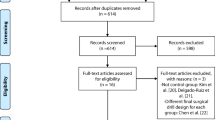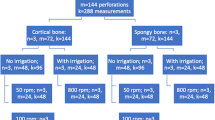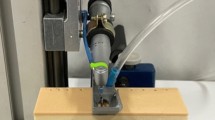Abstract
Statement of problem: Osseointegration is the more stable situation and results in a high success rate of dental implants. Heat generation during rotary cutting is one of the important factors influencing the development of osseointegration. Purpose: To assess the various factors related to implant drills responsible for heat generation during osteotomy. Materials and Methods: To identify suitable literature, an electronic search was performed using Medline and Pubmed database. Articles published in between 1960 to February 2013 were searched. The search is focused on heat generated by dental implant drills during osteotomy. Various factors related to implant drill such effect of number of blades; drill design, drill fatigue, drill speed and force applied during osteotomies which were responsible for heat generation were reviewed. Titles and abstracts were screened, and literature that fulfilled the inclusion criteria was selected for a full-text reading. Results: The initial literature search resulted in 299 articles out of which only 70 articles fulfils the inclusion criteria and were included in this systematic review. Many factors related to implant drill responsible for heat generation were found. Successful preparation of an implant cavity with minimal damage to the surrounding bone depends on the avoidance of excessive temperature generation during surgical drilling. Conclusion: The relationship between heat generated and implant drilling osteotomy is multifactorial in nature and its complexity has not been fully studied. Lack of scientific knowledge regarding this issue still exists. Further studies should be conducted to determine the various factors which generate less heat while osteotomy such as ideal ratio of force and speed in vivo, exact time to replace a drill, ideal drill design, irrigation system, drill-bone contact area.
Similar content being viewed by others
References
Brånemark P-I (1985) Introduction to osseointegration. In: Brånemark P-I, Zarb GA, Albrektsson T (eds) Tissue-integrated prostheses: osseointegration in clinical dentistry. Quintessence, Chicago, pp 11–76
Adell R, Lekholm U, Rockler R et al (1981) A 15 year old study of osseointegrated implant in the treatment of the edentulous jaw. Int J Oral Surg 10:387–416
Marco F, Milena F, Gianluca G, Vittoria O (2005) Peri-implant osteogenesis in health and osteoporosis. Micron 36:630–644
Linder L, Obrant K, Boivin G (1989) Osseointegration of metallic implants II. Transmission electron microscopy in rabbits. Acta Orthop Scand 60:135–139
Soballe K (1993) Hydroxyapatite coating for bone implant fixation. Mechanical and histological studies in dogs. Acta Orthop Scand 255:1–58
Khan SN, Cammisa FP Jr, Sandhu HS, Diwan AD, Girardi FP, Lane JM (2005) The biology of bone grafting. J Am Acad Orthop Surg 13:77–86
Eberhardt C, Habermann B, Muller S, Schwarz M, Bauss F, Kurth AH (2007) The bisphosphonate ibandronate accelerates osseointegration of hydroxyapatite coated cementless implants in an animal model. J Orthop Sci 12:61–66
Watanbe F, Tawada Y, Komatsu S, Hata Y (1992) Heat distribution in bone during preparation of implant sites: heat analysis by real-time thermography. Int J Oral Maxillofac Implants 7:212–219
Watzek G, Matejka M, Grundschober F, Plenk H Jr (1985) Enossale Implantate. Theoretische und morphologische Grundlagen — klinische Konsequenzen. Z Stomatol 82:27–49
Brånemark P-I (1983) Osseointegration and its experimental background. J Prosthet Dent 50:399–410
Watzek G, Matejka M, Lill W, Mailath G, Matzka P, Plenk H Jr (1988) Knöchern eingeheilte Implantate (Tübingen, IMZ, Brånemark) — Erfahrungen mit einem Therapiekonzept. Z Stomatol 85:207–233
Eriksson R, Albrektsson T (1983) Temperature threshold levels for heat induced bone tissue injury: a vital-microscopic study in the rabbit. J Prosthet Den 50:101–107
Eriksson RA, Albrektsson T (1984) The effect of heat on bone regeneration: an experimental study in rabbits using the bone growth chamber. J Oral Maxillofac Surg 42:705–711
Ercoli C, Funkenbusch PD, Lee H-J et al (2004) The influence of drill wear on cutting efficiency and heat production during osteotomy preparation for dental implants: a study of drill durability. Int J Oral Maxillofac Implants 19:335–349
Albrektsson T (1985) Bone tissue response. In: Brånemark P-I, Zarb GA, Albrektsson T (eds) Tissue-integrated prostheses: osseointegration in clinical dentistry. Quintessence, Chicago, pp 129–143
Tehemar SH (1999) Factors affecting heat generation during implant site preparation: a review of biologic observations and future considerations. Int J Oral Maxillofac Implants 14:127–136
Lavelle C, Wedgewood D (1980) Effect of internal irrigation on frictional heat generated from bone drilling. J Oral Surg 38:499–503
Rafel SS (1962) Temperature changes during high-speed drilling on bone. J Oral Surg Anesth Hosp Dent Serv 20:475
Matthews LS, Hirsch C (1972) Temperatures measured in human cortical bone when drilling. J Bone Joint Surg Am 54:297–308
Yacker M, Klein M (1996) The effect of irrigation on osteotomy: depth and bur diameter. Int J Oral Maxillofac Implants 11:634–638
Cordioli G, Majzoub Z (1997) Heat generation during implant site preparation: an in vitro study. Int J Oral Maxillofac Implantol 12:186–193
Chacon GE, Bower DL, Larsen PE, McGlumphy EA, Beck FM (2006) Heat production by 3 implant drill systems after repeated drilling and sterilization. J Oral Maxillofac Surg 64:265–269
de Souza Carvalho ACG, Queiroz TP, Okamoto R, Margonar R, Garcia IR, Filho OM (2011) Evaluation of bone heating, immediate bone cell viability, and wear of high-resistance drills after the creation of implant osteotomies in rabbit tibias. Int J Oral Maxillofac Implants 26:1193–1201
Sharawy M, Misch C, Weller N, Tehemar S (2002) Heat generation during implant drilling: the significance of motor speed. J Oral Maxillofac Surg 60:1160–1169
Haider R, Watzek G, Plenk H (1993) Effects of drill cooling and bone structure on imz implant fixation. Int J Oral Maxillofac Implants 8:83–91
Brisman D (1996) The effect of speed, pressure, and time on bone temperature during the drilling of implant sites. Int J Oral Maxillofac Implants 11:35–37
Allsobrook OFL, Leichter J, Holborow D, Swain M (2011) Descriptive study of the longevity of dental implant surgery drills. Clin Implant Dent Relat Res 13(3):244–254
Harris B, Kohles S (2001) Effects of mechanical and thermal fatigue on dental drill performance. Int J Oral Maxillofac Implants 16:819–826
Jun OhH, Wikesjo UM, Kang HS, Ku Y, Eom TG, Koo KT (2011) Effect of implant drill characteristics on heat generation in osteotomy sites: a pilot study. Clin Oral Implants Res 22:722–726
Sener BC, Dergin G, Gursoy B, Kelesoglu E, Slih I (2009) Effects of irrigation temperature on heat control in vitro at different drilling depths. Clin Oral Implant Res 20:294–298
Benington IC, Biagioni PA, Briggs J, Sheridan S, Lamey PJ (2002) Thermal changes observed at implant sites during internal and external irrigation. Clin Oral Implant Res 13:293–297
Sumer M, Misir AF, Telcioglu NT, Guler AU, Yenisey M (2011) Comparison of heat generation during implant drilling using stainless steel and ceramic drills. J Oral Maxillofac Surg 69(5):1350–1354
Misir AF, Sumer M, Yenisey M, Ergioglu E (2009) Effect of surgical drill guide on heat generated from implant drilling. J Oral Maxillofac Surg 67(12):2663–2668
Watanabe F, Tawada Y, Komatsu S, Hata Y (1990) Heat distribution within the bonetissue by rotary cutting instrument for IMZ implant. Heat analysis by a real-time thermography. Nihon Hotetsu Shika Gakkai Zasshi 34(1):18–24
Iyer S, Weiss C, Mehta A (1997) Effects of drill speed on heat production and the rate and quality of bone formation in dental implant osteotomies. Part I: relationship between drill speed and heat production. Int J Prostbodont 10:411–414
Iyer S, Weiss C, Mehta A (1997) Effects of drill speed on heat production and the rate and quality of bone formation in dental osteotomies. Part II: relationship between drill speed and healing. Int J Prosthodont 10:411–414
Kohles SS, Bowers JR, Vailas AC, Vanderby R Jr (1997) Ultrasonic wave velocity measurement in small polymeric and cortical bone specimens. J Biomech Eng 119:232–236
Johnson AT (1998) Biological process engineering: an analogical approach to fluid flow, heat transfer, and mass transfer applied to biological systems. Wiley, New York, pp 262–493
Lundskog J (1972) Heat and bone tissue. An experimental investigation of the thermal properties of bone tissue and threshold levels for thermal injury. Scand J Plast Reconstr Surg 6(suppl 9):5–75
Eichler J, Berg R (1972) Temperatureinwirkung auf die Kompakta beim Bohren, Gewindeschneiden und Eindrehen von Schrauben. Z Orthop 110:909–913
Rhinelander FW (1974) The normal circulation of bone and its response to surgical intervention. J Biomed Mater Res 8:87–90
Tetsch P (1974) Development of raised temperature after osteotomies. J Maxillofac Surg 2:141–145
Huiskes R (1980) Some fundamental aspects of human joint replacement. Analyses of stresses and heat conduction in bone-prosthesis structures. Acta Orthop Scand 185:1–208
Roberts WE, Turley PK, Brezniak N, Fielder PJ (1987) Bone physiology and metabolism. CDA J 10:54–61
Eriksson A, Albrektsson T, Grane B, McQueen D (1982) Thermal injury to bone: a vital-microscopic description of heat effects. Int J Oral Surg 11:115–121
Eriksson RA, Albrektsson T, Magnusson B (1984) Assessment of bone viability after heat trauma. A histological, histochemical and vital microscopic study in the rabbit. Scand J Plast Reconstr Surg 18:261–268
Albrektsson T, Eriksson A (1985) Thermally induced bone necrosis in rabbits: relation to implant failure in humans. Clin Orthop 195:311–312
Truhlar RS, Morris HF, Ochi S et al (1994) Second stage failures related to bone quality in patients receiving endosseous dental implants: DICRG Interim report #7. Implant Dent 3:252–255
Mann V, Huber C, Kogianni G et al (2006) The influence of mechanical stimulation on osteocyte apoptosis and bone viability in human trabecular bone. J Musculoskelet Neuronal Interact 6:408–417
Nomura S, Takano-Yamamoto T (2000) Molecular events caused by mechanical stress in bone. Matrix Biol 19:91–96
Takai E, Mauck RL, Hung CT et al (2004) Osteocyte viability and regulation of osteoblast function in a 3D trabecular bone explant under dynamic hydrostatic pressure. J Bone Miner Res 19:1403–1410
Ocarino NM, Gomes MG, Melo EG (2006) Técnica histoquímica aplicada ao tecido ósseodesmineralizado e parafinado para o estudo do osteócito e suas conexões. J Bras Patol Med Lab 42:37–42
Bonewald LF (2002) Osteocytes: a proposed multifunctional bone cell. J Musculoskelet Neuronal Interact 2:239–241
Nagai M, Hayakawa T, Fukatsu A et al (2002) In vitro study of collagen coating of titanium implants for initial cell attachment. Dent Mater J 21:250–260
Rammelt S, Schulze E, Bernhardt R et al (2004) Coating of titanium implants with type I collagen. J Orthop Res 22:1025–1034
Woo KM, Choi Y, Ko S-H et al (2002) Osteoprotegerin is present on the membrane of osteoclasts isolated from mouse long bones. Exp Mol Med 34:347–352
Crotti TN, Smith MD, Findlay DM et al (2004) Factors regulating osteoclast formation in human tissues adjacent to peri-implant bone loss: expression of receptor activator NFKappaB, RANK ligand and osteoprotegerin. Biomaterials 25:565–573
Bucay N, Sarosi I, Dunstan CR et al (1998) Osteoprotegerin-deficient mice develop early onset osteoporosis and arterial calcification. Genes Dev 12:1260–1268
Khosla S (2001) Mini review: the OPG/RANKL/RANK system. Endocrinology 142:5050–5055
Rogers A, Eastell R (2005) Review: circulating osteoprotegerin and receptor activator for nuclear factor kB ligant: clinical utility in metabolic bone disease assessment. J Clin Endocrinol Metab 90:6323–6331
Lieberman JR, Daluiski A, Einhorn TA (2002) The role of growth factors in the repair of bone. Biology and clinical applications. J Bone Joint Surg Am 84:1032–1044
Thorwarth M, Rupprecht S, Falk S et al (2005) Expression of bone matrix proteins during de novo bone formation using a bovine collagen and platelet-rich plasma (prp)—an immunohistochemical analysis. Biomaterials 26:2575–2584
Rammelt S, Neumann M, Hanisch U et al (2005) Osteocalcin enhances bone remodeling around hydroxyapatite/collagen composites. J Biomed Mater Res 73:284–294
Lekholm U (1983) Clinical procedures for treatment with osseointegrated dental implants. J Prosthet Dent 50:116–120
Kirschner H, Meyer W (1975) Entwicklung einer Innenkühlung für chirurgische Bohrer. Dtsch Zahnärztl Z 30:436–438
Seeger P, Tetsch P (1978) Tierexperimentelle Untersuchungen zur Regeneration genormter Knochendefekte bei unterschiedlichen Kühlverfahren. Dtsch Zahnärztl Z 33:870–872
Schmitt W, Weber HJ, Jahn D (1988) Thermische Untersuchungen beim Bohren in kortikalem Knochen unter Verwendung verschiedener Kühlsysteme. Dtsch Zähnarztl Z 43:802–805
Kirschner H, Bolz U, Michel G (1984) Thermometrische Untersuchungen mit innen- und ungekühlten Bohrern an Kieferknochen und Zähnen. Dtsch Zahnärztl Z 39:30–32
Oberg E, Jones FD, Horton HL (1989) Machinery’s handbook, 23rd edn. Industrial, New York, pp 716–729
Thompson HC (1958) Effect of drilling into bone. J Oral Surg 16:22–30
Medical Data International (1999) U.S. Markets for dental implants and dental bone substitutes. Medical Data International, Cary
Jochum RM, Reichart PA (2000) Influence of multiple use of Timedur titanium cannon drills: thermal response and scanning electron microscopic findings. Cin Oral Implants Res 11:139–143
Scarano A, Carinci F, Quaranta A et al (2007) Effects of bur wear during implant site preparation: an in vitro study. Int J Immunopathol Pharmacol 20(1 suppl 1):23–26
Sutter F, Krekeler G, Schwammerger AE, Sutter FJ (1992) Atraumatic surgical technique and implant bed preparation. Quintessence Int 23:811–816
Pallan FG (1960) Histological changes in bone after insertion of skeletal fixation pins. J Oral Surg Anesth Hosp D Serv 18:400–408
Eriksson RA, Albrektsson T, Albrektsson B (1984) Temperature measurements at drilling in cortical bone in vivo. Heat induced bone tissue injury [Postdoctoral thesis]. University of Goteborg, Goteborg, pp 41–43
Hobkirk J, Rusiniak K (1977) Investigation of variable factors in drilling bone. J Oral Surg 35:968–973
Reingewirtz Y, Szmukler-Moncler S, Senger B (1997) Influence of different parameters on bone heating and drilling in implantology. Clin Oral Implant Res 8:189–197
Eriksson R, Adell R (1986) Temperatures during drilling for the placement of implants using the osseointegration technique. J Oral Maxillofac Surg 44:4–7
Abouzgia MB, James DF (1995) Measurements of shaft speed while drilling through bone. J Oral Maxillofac Surg 53:1308–1315
Abouzgia NB, Symington JM (1996) Effect of drill speed on bone temperature. Int J Oral Maxillofac Surg 25:394–399
Abouzgia MB, James DF (1997) Temperature rise during drilling through bone. Int J Oral Maxillofac Implants 12:342–353
Author information
Authors and Affiliations
Corresponding author
Rights and permissions
About this article
Cite this article
Mishra, S.K., Chowdhary, R. Heat Generated by Dental Implant Drills During Osteotomy—A Review. J Indian Prosthodont Soc 14, 131–143 (2014). https://doi.org/10.1007/s13191-014-0350-6
Received:
Accepted:
Published:
Issue Date:
DOI: https://doi.org/10.1007/s13191-014-0350-6




